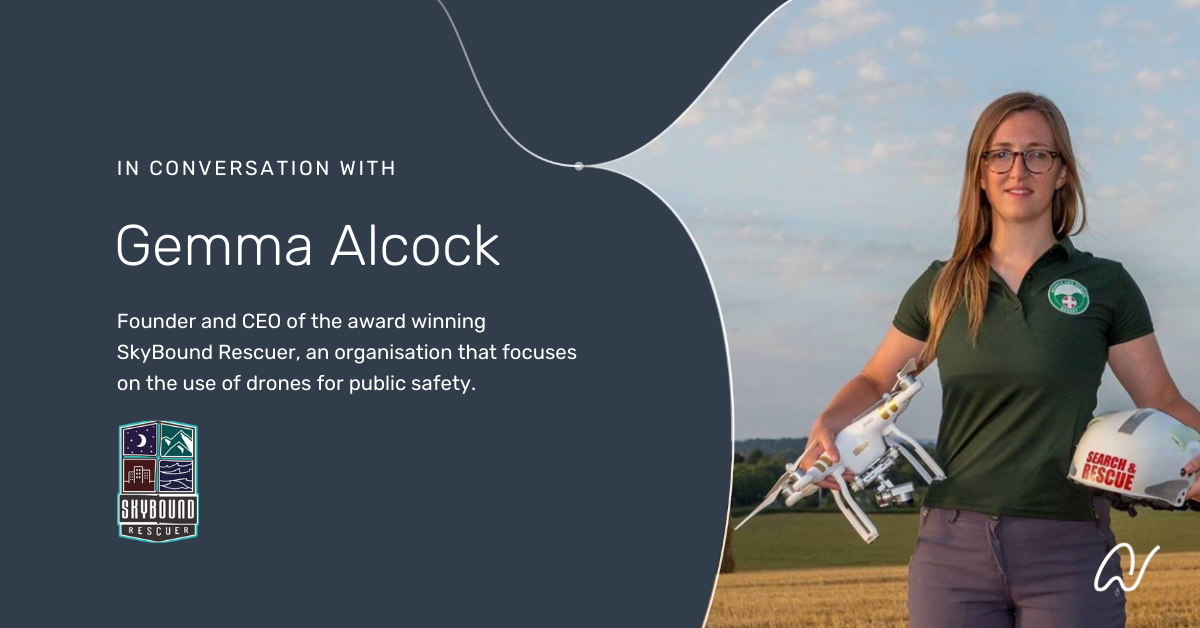In Conversation With
Each week, Airwards chats to someone in the drone industry doing incredible work. We uncover what they do, what makes them tick, where they see the drone industry headed, and discuss positive drone use.
Romeo Durscher is one of the drone industry’s top executives and a leader in aerospace, unmanned aerial systems and Public Safety. Recently joining Auterion as Vice President, Romeo spent six years prior at DJI building the Public Safety vertical, as well as almost 13 years working on a NASA space project.
He was named one of the 25 Most Influential People in the Drone Industry by Commercial UAV and one of 7 visionaries in Public Safety. In this latest conversation, we talk to Romeo about the growth of the drone industry, how this technology is transforming global emergency services for the better, and what his hopes are for the future of drones.
“My vision for drones is that they become the catalyst for more innovation, more use cases, more motivation and inspiration. Drones will drive new processes and workflows that make our lives safer, simpler, and allow us to interact with our environment differently. Ultimately, drones will lead us to new discoveries, here on earth, and on other planets.”
1 | How does Auterion help drone operators?
First and foremost, Auterion is a software company. Our goal is to transform how commercial entities, humanitarian organisations and emergency response teams collect and analyse data, how they improve and simplify workflows, pre-plan missions, and as a result, get actionable data faster. By ensuring information gets to the right people in real-time, they’re empowered to make better, faster and more effective decisions.
We do this by leveraging a hardware piece named Skynode. Skynode is the brain of an Auterion powered drone; it’s a PX4 based flight controller with a mission computer and a connectivity solution. This device provides any drone manufacturer with a leading Ready-To-Fly flight controller, a component to integrate payloads and transfer data so that they can focus on building the drone; so it’s a fast-track to market. For the end users it means a solution which fully integrates into the Auterion Suite - a fleet management, mission planning, mission execution, and true vehicle health data and maintenance hub, on steroids.
2 | How is Auterion’s ‘open source community’ accelerating the growth of the drone industry?
Looking at how the drone market is growing and how fast use cases are being developed, drone companies are faced with the challenge of keeping up with the demand for new features, while also developing and maintaining challenging flight software. This is a huge task, but open source makes it fast and simple. Instead of building everything themselves, drone companies can leverage the open source platform around PX4 and build customer-relevant features on top. No reinventing of the wheel needed.
For the end user, open source means they get more features quicker, in a standardised approach. They can streamline their fleet, while having choices on what drones and payloads they want and need (the carrying capacity of a drone), from different manufacturers. Imagine you have five different drones with different payloads; four multirotors and one VTOL (Vertical Take Off and Landing) platform; but you have one radio and you can bind that radio to all five, fly all these different drones with the same user interface, know exactly where all functions are located and expect exactly the same behaviour with each of these very different drones. This totally streamlines your programme. Your training is simplified and focused, your deployments are more efficient, your experience is much more satisfying, and your data is going through the same pipeline, no matter which drone was flown.
3 | You’ve been credited with building DJI’s Public Safety vertical and have had a major role in developing products for police and fire departments. How are new technologies like drones revolutionising global emergency services?
There was a time when people told me that it did not make sense to put effort in trying to get (consumer) drones into public safety. High ranking officials used to say they didn’t want ‘toys’ in their departments. That didn’t shock or discourage me. Doing something radical, something that has never been done before - especially in a very traditional setting - often gets pushback.
Drones have become a vital tool in the inventory of emergency response. As new technology and deployment methodology, drones allow the creation of a new team or unit. Many departments now have a UAV Team, with dedicated vehicles. Drones are frequently used in squad vehicles for quick deployments, and some departments have drones on top of their stations, taking off and flying straight to an incident area, becoming the true first responder on scene, providing immediate situational awareness, while ground units are still on route. While drones were really born on the consumer side, they have become more mature to serve the commercial markets.
Drones have changed the way emergency personnel can respond. They help keep our first responders safer, allow for faster response time, better response decisions, they save lives and properties - all while increasing transparency. Over 550 documented lives have been rescued by drones, however I expect the real number is much, much higher. They have also helped prevent injury and death to many first responders, which has a huge emotional and economical impact.
4 | What would you say to anyone considering entering Airwards?
We work in an industry with amazing stories, written by incredible people. Stories that are humble, stories that are insane, stories that are motivating. But many of these stories are not being told and shared, because there is no platform or person to tell the story. Airwards is a place to share these stories, developments and projects - the visions which drive our industry and inspire the next generation of engineer, inventor, drone operator, or artist.
Everyone has a story. The last 10 years are filled with incredible accounts and accomplishments. I encourage everyone to find a category and tell your story through Airwards. Let others read about your success and the lessons learned.
5 | What is your vision and hope for the future of drones?
Many have the vision of cargo drone deliveries all over the place. Others envision the drone taxi to get from Point A to Point B.
My vision for drones is that they become the catalyst for more innovation, more use cases, more motivation and inspiration. I look back at the 1960s with the Apollo space programme and our goal to reach the Moon and bring back the crew. We built something so new, worked together, got inspired - and through all of that, not only reached the Moon, but eventually built the International Space Station, which now provides many scientific research breakthroughs. Along the way, new inventions have been made, with many making it into our everyday lives. For example, ventricular assist devices (heart pumps), LASIK (laser eye surgery), invisible braces, CMOS image sensors (built into today’s digital cameras and mobile phones) - and so many more.
As catalysts for further innovation, drones will drive new processes and workflows that make our lives safer, simpler and allow us to interact with our environment differently. Ultimately, drones will lead us to new discoveries, here on earth, and on other planets. Just like the first helicopter drone that just landed on Mars (read more here).
About Romeo
Romeo Durscher is a leading UAS executive. Prior to joining Auterion earlier this year, Romeo held the role of Senior Director of Public Safety Integration at DJI, where he was responsible for bringing new technologies to emergency services. Prior to joining DJI, Romeo spent twelve years working on NASA’s Heliophysics Mission Solar Dynamics Observatory at Stanford University. He is also an author, aerial photographer, science educator, social media leader and conference keynote speaker.
Connect with Romeo on LinkedIn and visit Auterion for more information.

















